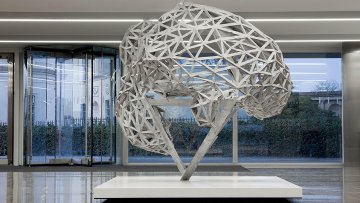Branch groups: groups that look like trees
Abstract
Groups which act on rooted trees, and branch groups in particular, have provided examples of groups with exotic properties for the last three decades. This and their links to other areas of mathematics such as dynamical systems has made them the object of intense research.
One of their more useful properties is that of having a "tree-like" subgroup structure, in several senses.
I shall explain what this means in the talk and give some applications.
As you enter the main entrance lobby of the Andrew Wiles Building you are greeeted by Axiom. Created by artist Mat Chivers, the sculpture is the winner of the Mathematical Institute's Sculpture Competition. The competition invited artists to propose, and eventually create, a substantial and artistically significant sculpture to be placed in the main entrance lobby. We would encourage you all to visit and meanwhile allow Mat to explain the work and its construction.
Efficient optimization algorithms for nonlinear least-squares and inverse problems
Abstract
16:00


